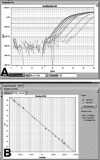Genetic differentiation of appendiceal tumor malignancy: a guide for the perplexed
- PMID: 16794389
- PMCID: PMC1570599
- DOI: 10.1097/01.sla.0000217617.06782.d5
Genetic differentiation of appendiceal tumor malignancy: a guide for the perplexed
Abstract
Objective: To use differential gene expression of candidate markers to discriminate benign appendiceal carcinoids (APCs) from malignant and mixed cell APCs.
Summary background data: Controversy exists in regard to the appropriate surgical management of APCs since it is sometimes difficult to predict tumor behavior using traditional pathologic criteria. We have identified 5 differentially expressed genes (a mitosis-regulatory gene NAP1L1, an adhesin MAGE-D2, an estrogen-antagonist, the metastasis marker MTA1, the apoptotic marker NALP, and chromogranin A) that define gut neuroendocrine cell behavior.
Methods: Total RNA was isolated using TRIzol reagent from 42 appendiceal samples, including appendiceal carcinoids identified at exploration for appendicitis (no evidence of metastasis; n = 16), appendicitis specimens (n = 11), malignant appendiceal tumors (> 1.5 cm, evidence of metastatic invasion; n = 7), and mixed (goblet) cell appendiceal adenocarcinoids (n = 3), normal appendiceal tissue (n = 5), and 5 colorectal cancers. Gene expression (CgA, NAP1L1, MAGE-D2, MTA1, and NALP1) was examined by Q-RT PCR (Applied Biosystems) and quantified against GAPDH.
Results: CgA message was elevated (> 1000-fold, P < 0.05) in all tumor types. NAP1L1 was elevated (> 10-fold, P < 0.03) in both malignant and goblet cell adenocarcinoids compared with normal and incidental lesions (P < 0.006). MAGE-D2 and MTA1 message were significantly elevated (> 10-fold, P < 0.01) in the malignant and goblet cell adenocarcinoid tumors but not in the appendicitis-associated carcinoids or normal mucosa. The apoptotic marker, NALP1, was overexpressed (> 50-fold, P < 0.05) in the appendicitis-associated and malignant appendiceal carcinoids but was significantly decreased (> 10-fold, P < 0.05) in the goblet cell adenocarcinoids. Elevated CgA transcript and protein levels indicative of a carcinoid tumor were identified in one acute appendicitis sample with no histologic evidence of a tumor.
Conclusions: These data demonstrate that malignant APCs and goblet cell adenocarcinoids have elevated expression of NAP1L1, MAGE-D2, and MTA1 compared with appendiceal carcinoids identified at surgery for appendicitis. This and the differences in NALP1 gene expression (decreased in goblet cell adenocarcinoids) provide a series of molecular signatures that differentiate carcinoids of the appendix. CgA identified all appendiceal tumors as well as covert lesions, which may be more prevalent than previously recognized. The molecular delineation of malignant appendiceal tumor potential provides a scientific basis to define the appropriate surgical management as opposed to morphologic assessment alone.
Figures








References
-
- Modlin I. History of Gastroenterology at the Millenium. Milan: MultiMed, 2000.
-
- Sandor A, Modlin IM. A retrospective analysis of 1570 appendiceal carcinoids. Am J Gastroenterol. 1998;93:422–428. - PubMed
-
- Bernick PE, et al. Neuroendocrine carcinomas of the colon and rectum. Dis Colon Rectum. 2004;47:163–169. - PubMed
-
- Goede AC, Caplin ME, Winslet MC. Carcinoid tumour of the appendix. Br J Surg. 2003;90:1317–1322. - PubMed
-
- Simon SR. Moses Maimonides: medieval physician and scholar. Arch Intern Med. 1999;159:1841–1845. - PubMed
Publication types
MeSH terms
Substances
Grants and funding
LinkOut - more resources
Full Text Sources
Other Literature Sources
Medical
Research Materials
Miscellaneous

